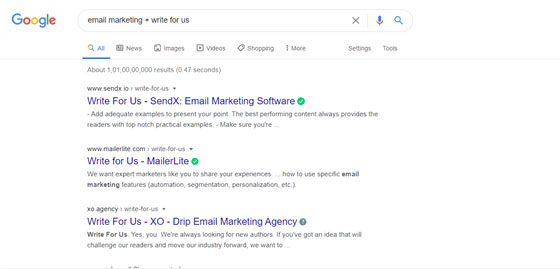
Over the last year, I’ve supported the content teams at a dozen global companies in the marketing niche. We’ve helped our clients secure guest post opportunities on sites like Hubspot, CoSchedule, and others. The guest posts we’ve secured have helped our clients increase their organic search rankings and generate more referral traffic.
This guide will cover the system that we use to secure guest post opportunities for ourselves and our clients. You can use this system to land your first guest post, a couple of posts a month, or 50-100 guest posts a month. The guest post strategy is battle-tested and effective at every level.
Why guest posting is important
Guest posting is one of the best ways to expose your target
audience to your business and improve your link building game to
rank in the search results for the terms that matter to your business so you
can profit from your content.
Importantly, guest posting is not just about Search Engine
Optimization (SEO). You can leverage guest posts to increase brand awareness
and generate qualified leads. For example, I reference guest posts in all my
sales outreach.

As you can see, it’s an effective strategy.
Writing guest posts can also help you expand your personal and professional networks. Those relationships will play a role as you develop your professional career.
Why do you need a guest post system?
I'm privileged to be running a rapidly growing company that
offers guest post services to clients. Going from three employees to 12 staff,
we have experienced growing pains. To improve our business operations’
efficiency and manage growth, I’ve tried to systemize every repetitive task we
undertake.
Systems help you improve your business operations, but they need
to be flexible. In addition to your guest post system, you’ll need a process
for managerial oversight to ensure everything is implemented correctly.
So what is a good guest post system? In the next section, we look at a checklist that you can use to create the ideal strategy to start securing guest posts for your business.
Guest post checklist
Your guest post checklist should cover everything from how you will reach out to other publications to submitting your content. Think of it like any other part of your business. You must attract the consumer and then deliver excellent service to ensure they keep coming back. Here’s our six-point checklist.
1. How to create
your target website list
The first step of the outreach process is data collection. You
need to make a comprehensive list of suitable sites in your niche that might
accept your content.
There are a couple of ways to do that.
In the example below, I searched for blogs that accept guest
posts for email marketing. You can
try variations of this with “niche+ guest posts/write for us/contributor
guidelines” to come up with a few suitable sites.

Strategies like the one I shared above are ok for people who are
experimenting with guest blogging. It’s difficult to generate lists of hundreds
of potential sites with this approach.
We use Ahrefs to generate lists of sites for guest post
outreach. Premium SEO tools like Ahrefs help you create lists of sites that
share SEO characteristics at scale and fast.
The first thing you should do is select an authority site in
your niche. For example, in the marketing niche, we might choose an authority
site like Hubspot. Once you’ve picked the site, select referring domains, then
export the list.

You now need to create a shortlist of relevant domains. If you
use Ahrefs, I recommend you start by removing all sites with a Domain Rating of
49 or less.
Sites with a low Domain Rating (DR) generally have minimal
traffic and provide little SEO or PR value.
Outside of DR or Domain Authority (DA), there are other factors
you will need to consider. They include:
●
Niche relevancy
●
Number of visitors
●
Trust Flow (TF)
We use Majestic to sift sites quickly for niche relevancy. We
then remove sites with less than 3,000 monthly visitors or have a Trust Flow of
less than 15.
It usually takes us a couple of hours to create a list of 400+
websites for outreach. We’ll send guest post pitches to all of the sites on a
list. We conduct a secondary review of sites that respond to our guest post
inquiry. During the secondary check, we’ll closely inspect things like site
traffic over time.
We don’t post on sites that have seen a sudden or sustained dip
in traffic.

The secondary inspection is our chance to catch sites with good
stats but have Google penalties. Getting a link from a site with a Google
penalty can harm your search rankings.
We also check traffic by country. For example, if we’re looking
to rank content in the UK, it makes sense if we target sites with a decent
audience in the country.
Keep in mind, only a fraction of the sites you email will respond to your inquiry. It’s faster to conduct a comprehensive SEO review of the sites that respond to an inquiry than it is to review all of the websites you plan to message. That’s assuming you’re doing outreach at scale.
2. Connecting with
editors and finding email addresses
After you’ve created a list of sites to target, the next step is
to find the right people to contact. Many sites have an editorial team and a
shared email address where you can pitch your ideas. You’ll often find this
email address on the guest post page.
The quickest way to find the guest post submission page is to do the following search on Google - “site:website.com guest post.” Replace the text in bold with your target website URL.
Below is the result I got when I did the following search on Google - site: process. guest post.

The second item in the search results is the guest post guidelines for the site. A quick review of the editorial guidelines provides an overview of the best way to submit your pitch.
If there is no guest post page or the submission process is unclear, it’s best to get the editor’s email address. LinkedIn is a great source for contact information; search the target site’s name and job titles like “Editor” or “Content Manager.”
Once you have their name, use an email finder to get their details. I use Voila Norbert. Here’s a link to their email finder which provides some free credits.
You should now have a list of sites and the contact information for the editors. The next step in the process is to create your email outreach template.
3. The perfect email outreach template
Editors do not have time to go through a long email about your business. Keep the email short, to the point, and share your expertise.

The email is straightforward and to the point.
Always personalize the email with the name of the person and the website.
For ideas of what not to do, read this informative article by Make a Living Writing, where seven editors vent about what not to do when approaching them with an idea. My personal favourite is Smart Blogger’s managing editor’s advice: “Don’t send pitch emails addressed to “Dear blog owner.” Too lazy to find out the name of the blog owner or editor? I’ll assume you’re too lazy to write a good post, too.”
Regardless of how good your email template is, most people probably won’t respond to your email. Pitching ideas after you receive a response is a simple timesaver when conducting outreach at scale.
You can use software to track email opens and clicks. With the right software, you can split test templates and zero in on the one that works the best. You should continue to track and test templates even after you’ve found one that seems to work.
Of course, you still need to come up with some great ideas.
4. How to come up with guest post ideas
Coming up with relevant guest post ideas for a site is a skill. You need to identify suitable topics that a site hasn’t covered before but which they might find interesting. Ideally, that topic should also be relevant to your expertise.
We use a combination of Google and Keywords Everywhere to come up with guest post ideas.
First, review the website—a quick review of the previous 20 or 30 blog headlines will give you an idea of the type of content the site publishes. Once you’ve reviewed the website, create a list of relevant keywords. A tool like Keywords Everywhere will provide you with an overview of related search terms and the search volume.

Related search terms are a great way to come up with potential topics. Focus on the terms that have a search volume of 720+. Ideally, the competition for the terms should be less than 0.3.
As you do these searches, you’ll start to identify keywords that you think would be relevant for a guest post. Now check if they have written about the topic.
You can use the following search string to check the results: “site:sitename.com keyword.”
Here’s an example.

If you use the search string, and no relevant result appears in the search engine results, you’re good to go. Otherwise, repeat this process until you have at least three relevant keyword ideas.
Finally, create a suitable headline that incorporates the keyword.
Keep in mind, the role of an editor at a site is to create quality content that will engage their audience and increase website traffic. For this reason, editors are more likely to accept a guest post with a relevant keyword that might bring traffic to their site.
5. Editorial guidelines for writing great content
Your pitch has been accepted. Now you have to create the post that will go up on the website. A strong editorial process helps you send out great content consistently. Having an editorial and content management system in place can help fine-tune creative processes.
Ensure you read the site’s guest post guidelines thoroughly before you begin and tailor your content to fit the site’s tone. Not following the guidelines is the quickest way to get your content rejected!
Finally, and this is important, make sure your writers have guidelines to reference. Your editorial guidelines or style guide should set out your expectations for creating Grade A awesome content.
Here are a few of my top tips for great content:
● Keep the tone conversational.
● Include lots of actionable tips that readers can follow.
● Include images such as graphs, charts, screenshots, and infographics.
● Avoid long chunks of text and use lots of sub-headings.
Once you’ve completed your piece, read it back to make sure you’ve covered everything. You should also double-check your grammar. Here’s a list of the best Grammarly alternatives.
Mistakes can take away from the content’s credibility.
You can use a project management tool to track the content you produce.
A strong editorial system, combined with clear writer guidelines, will help you create great content. Out of all the processes shared in this post, I’d argue that this is the hardest step. You need a great editor and good writers to create content that will be accepted by authority publications.
6. What to do before you send your content
You have a great article and are nearly ready to send it across for submission, but we need to make a few more checks before you do that. Firstly, check one more time to ensure the article has ticked all the boxes on the site’s guidelines.
Next, check any claims in your article and ensure you have cited and linked to your sources. You want to make sure that the article is credible and accurate. Provide informative links to other sites where the readers can read about sub-topics in greater detail, and never link to your site more than twice.
Ensure that the article’s title is eye-catching and that the content is optimized for search engines using the relevant keywords.
Finally, add your bio that tells the readers who you are and what your business does. Keep the biography short and engaging. Include links to your social profiles where the readers can connect with you. It can be a great way to continue the conversation.
Wrapping up
This guest post checklist provides you with a framework for consistently creating and landing guest post opportunities. From identifying your target websites to getting your content published, these tips will put you in a position to secure guest post opportunities consistently.
Start by identifying target websites relevant to your niche and find the names of the editors. Create an outreach email template. When you receive a positive response, brainstorm guest post ideas using relevant tools. Finally, write your article and check it over for errors before sending it to the editor.
Guest posting can help you create long-term value for your brand and your site through quality backlinks, a broader audience, and an expanded professional network. Since this is a continuous process, it is advisable to establish a system to streamline your efforts.
Bio: Nico Prins is the founder of Launch Space. He works with SaaS companies helping them scale lead generation.




















Comments (3)
Enjoy Jetskiing in Dubai
May 02, 2025
Enjoy thrilling jetskiing adventures in Dubai with stunning views and high-speed excitement on the water. https://jetskirentaldubai.com/enjoy-jetskiing-in-dubai/
Luxury Boat Rentals in Dubai
May 02, 2025
Experience the ultimate in luxury with premium boat rentals in Dubai. Cruise in style with top-class yachts and exceptional service. https://luxuryyachtsdubai.com/luxury-boat-rentals-in-dubai/
Franklincalinton
Sep 16, 2024
Hi, This is Franklin, I am a digital marketing expert currently looking for some quality websites for guest posting. I recently visited your website and found it relevant to my niche and luckily you are also accepting guest posts. Please let me know if you are still interested in guest posts so we can discuss this further. Best Regards, Franklin.
Write a Comment